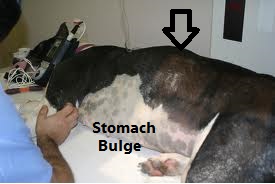 The word “Bloat” strikes horror in the hearts of many dog lovers – particularly those who have had to deal with it, and maybe even lost a good friend to it.
The word “Bloat” strikes horror in the hearts of many dog lovers – particularly those who have had to deal with it, and maybe even lost a good friend to it.
However, “Bloat” is a bit of a misnomer – the problem is not so much that the stomach filled up with gas, as that it flopped over and twisted itself about its own axis.
What Happens:
The course of a bloat-and-twist, or Gastric Dilatation and Volvulus (GDV), runs like this
- First, as the gas pressure builds up in the dog’s stomach, he starts to vomit – a LOT – trying to relieve the pressure.
- Once the stomach twists, what is inside the stomach can no longer come out, either upstream (vomiting) or downstream (out to the intestines). The dog still feels the urge to to relieve the pressure, but now nothing comes out when he vomits – it is just “dry heaving”, maybe with some saliva coming up.
- Ohh, the pressure… the stomach contents continue to ferment and make more gas, which has no way to exit the stomach. The pressure builds and squashes blood vessels, so they can not pass blood through normally.
- The compression of blood vessels in the stomach wall means that parts of the wall can start to die from lack of blood supply.
- But, even worse: the big blood vessel that returns all of the blood from the lower body to the heart, called the vena cava, runs through the abdomen just above the stomach and crossed the diaphragm just above where the esophagus does. All this pressure can cut off blood return to the heart, leading to shock and ultimately death.
What to Do?
At this stage, the only option is surgery.
- The pressure in the stomach is first partially relieved, either by passing a stomach tube down past the twist, or by passing a large-gauge needle through the body wall into the stomach. Either of these procedures has about a 75% chance* of relieving the pressure, so that the dog is more stable heading into surgery.
- In surgery, the stomach is untwisted – this part can be very risky, because when everything got twisted, so did the spleen and its blood supply. If the spleen was damaged by lack of blood supply, it can start to produce chemicals that, when they are released into the circulation by the untwisting, can cause blood pressure to plummet.
- The untwisted stomach is inspected, and if any parts of its wall have died, they are cut out and the healthy edges sewn back together.
- The last step of surgery is aimed at preventing this from ever happening again: it is called a “Pexy”. This means that the outer surface of the stomach wall gets tacked to the inner surface of the ribcage. Even if the stomach bloats again, it can not flop over and twist. This may also be done as a preventive surgery for dogs that have had an episode of bloat that did not end up twisting. Once they have shown that they can bloat, we want to make sure that they can not, in future, twist!
Can We Prevent It?
The main risk factor is related to how the dog is built: large breed dogs with a big chest have a deep enough abdomen that a bloated stomach can stretch really far up – and from there can flop over into a twist.
There are factors that are in our control, though:
- Amount fed: small meals are better. In a case-controlled study*, dogs fed large meals were at a higher risk of GDV, regardless of how many meals per day they were fed. The worst risk group were the ones fed one large meal per day.
- Fat content of the diet: in another case-control study* that looked at food ingredients, they found that foods that listed a fat or oil in the first four ingredients were more likely to precipitate GDV in a high risk dog. The study’s intent had been to look at whether there was a correlation between cereal or soy ingredients and GDV – there was not.
- Lifestyle and exercise: dogs that played with other dogs, got a lot of outdoor time, and had a chance to run in the yard after meals were at less risk of GDV than less active dogs*.
The best management strategy for GDV is to recognize it early. Outcomes are better if the dog is treated early, before tissue death or shock sets in. For this, recognition of the signs is paramount: please look at this video, that was taken of a rescued akita when he arrived at his new foster home. The rescuer and the foster parent had never seen bloat before and had no idea of what they were seeing. As soon as they realized something was wrong, he was rushed to the emergency vet.
*Article References available on request

